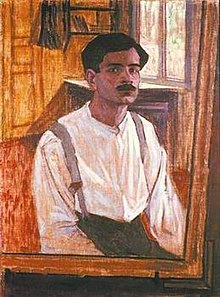David Kakabadze

Davit' Kakabadze (Georgian: დავით კაკაბაძე) (20 August 1889 – 10 May 1952) was a leading Georgian avant-garde painter, graphic artist and scenic designer. A multi-talent, he was also an art scholar and innovator in the field of cinematography as well as an amateur photographer. Kakabadze's works are notable for combining innovative interpretation of European "Leftist" art with Georgian national traditions, on which he was an expert.

Kakabadze was born into a poor peasant family in the village of Kukhi near the town of
Having returned to Georgia in 1927, Kakabadze continued his Imereti themes in new monumental decorative landscapes, including industrial landscapes. Around the same time, he collaborated with the leading Georgian theatre director Kote Marjanishvili to produce several set designs for Marjanishvili's theatre in Kutaisi. In 1931, he also produced a documental film "The Old Monuments of Georgia".[1]
Kakabadze became a professor at the Tbilisi State Academy of Arts in 1928, but came under pressure from Soviet authorities for "failure" to abandon Formalism and adapt to the dogmas of Social realism. Eventually, he was dismissed from the Academy in 1948.[2]
See also
- Sargis Kakabadze, David Kakabadze's brother and historian.
Further reading
- Kintsurashvili, Ketevan (2006), David Kakabadze, A 20th Century Classic. Tbilisi, ISBN 99940-60-10-4
- Kintsurashvili, Ketevan (2018) Z, The Plastic Ornament of the Epoch: David Kakabadze, PWN, Warsaw, ISBN 978-83-01-20283-5 [3]
- Kintsurashvili, Ketevan, and Janiashvili, David, David Kakabadze, PWN, Warsaw, 2018, ISBN 978-83-01-20301-6 [4]
- Kintsurashvili, Ketevan (2013), David Kakabadze, Georgian Modern Artist and Inventor, New York: Nova, ISBN 9781619428508.
- Kintsurashvili, Ketevan, and Janiashvili, David (2013), David Kakabadze, Tbilisi: Bakur Sulakauri Publishing, ISBN 978-9941-15-786-8 [5]
- Кинцурашвили, Кетеван (2002), Давид Какабадзе, Классик XX Века, Арбат: Санкт-Петербург.
References
- ISBN 1-884446-00-0.
- ^ Kintsurashvili, Ketevan (Winter, 2005), David Kakabadze – A Great Georgian Modernist[permanent dead link]. "Z" - Ketevan Kintsurashvili's ART LINE. Retrieved on 2008-06-13.
- ISBN 978-83-01-20283-5.
- ISBN 978-83-01-20301-6.
- ISBN 978-9941-15-786-8.
External links
- David Kakabadze's photography. Georgian Museum of Photography.
- Website about David Kakabadze
